Unit 2 Be sporty, be healthy Extended reading (教学课件)-高中英语译林版(2020)必修第二册(共34页PPT)
文档属性
| 名称 | Unit 2 Be sporty, be healthy Extended reading (教学课件)-高中英语译林版(2020)必修第二册(共34页PPT) |  | |
| 格式 | pptx | ||
| 文件大小 | 59.3MB | ||
| 资源类型 | 试卷 | ||
| 版本资源 | 牛津译林版(2019) | ||
| 科目 | 英语 | ||
| 更新时间 | 2025-07-28 09:32:57 | ||
图片预览



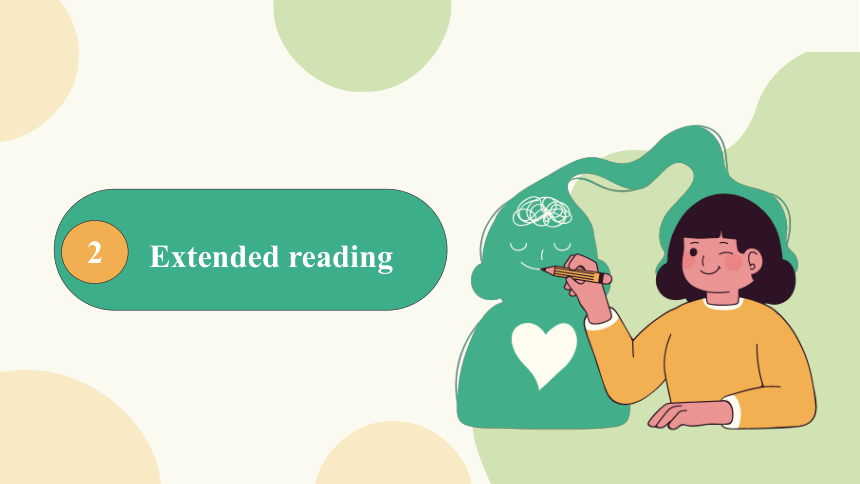
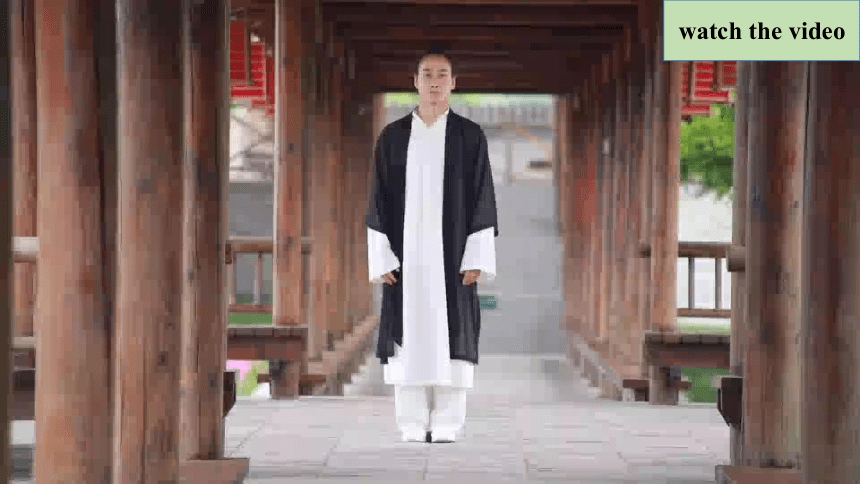
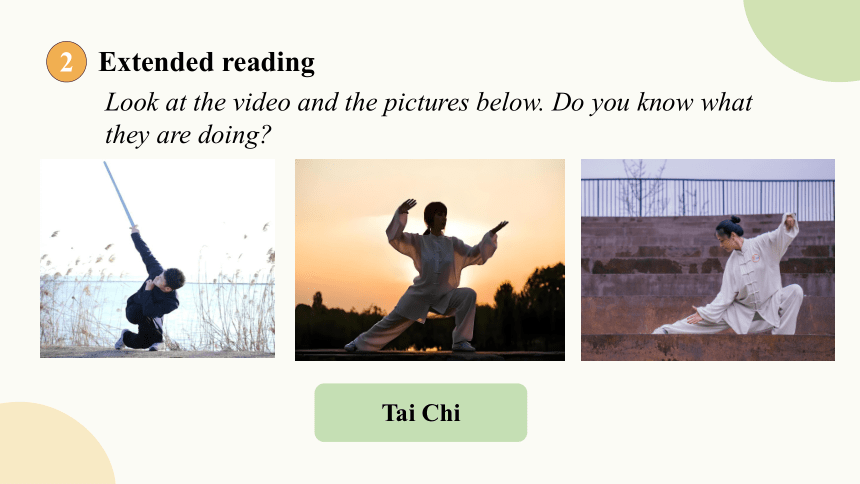

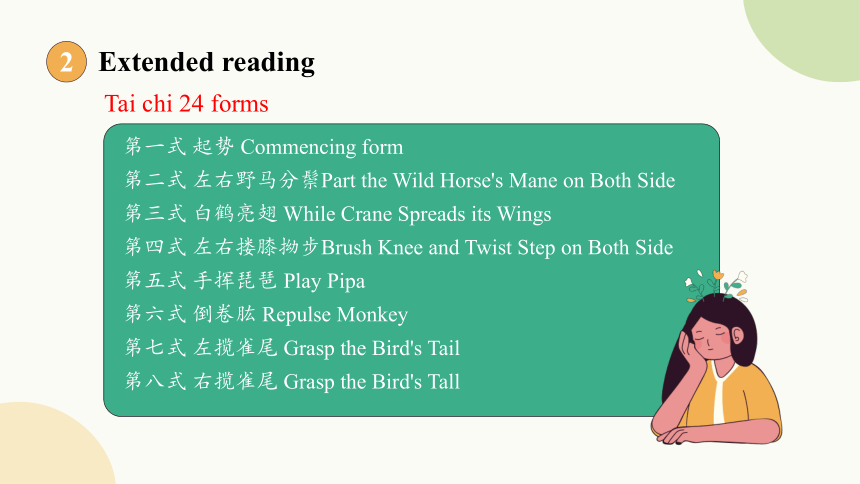

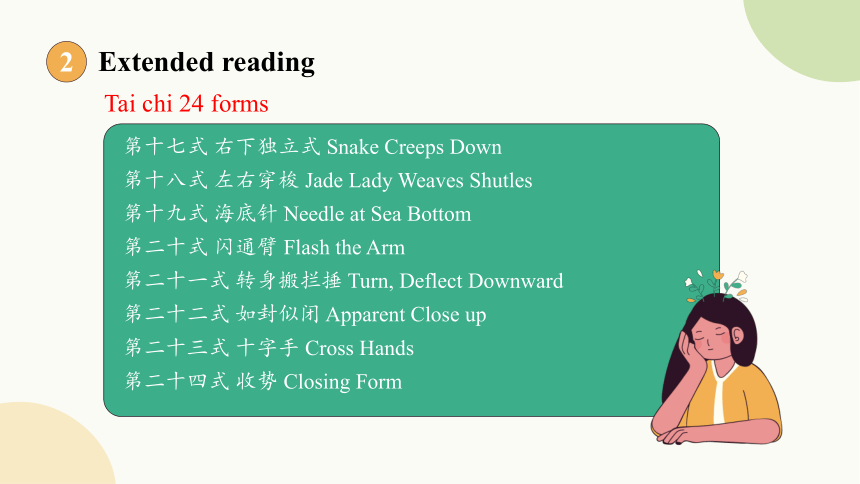


文档简介
(共33张PPT)
Unit 2
Be sporty, be healthy
Extended reading
Learning Objectives
1
1
Learning Objectives
01
02
Thinking Quality: Be aware of the positive impact of exercise on health and develop the good habit of regular exercise.
Language ability: Be able to introduce the basic knowledge of Tai Chi, including its moves, origin, meaning, benefits, etc.
03
Learning ability: Learn to design questionnaires and make reports based on the content of the questionnaires.
04
Cultural Awareness: Understand the significance and meaning of Tai Chi, appreciate the important position of Chinese culture in the world, establish a sense of awareness of Chinese culture, strengthen cultural confidence, and actively spread and promote the excellent traditional Chinese culture.
Extended reading
2
2
Extended reading
watch the video
Look at the video and the pictures below. Do you know what they are doing
2
Extended reading
Tai Chi
Tai Chi is a Chinese system of slow meditative physical exercise designed for relaxation and balance and health. It is not only an ancient martial art, but has also been widely acknowledged as an effective health exercise.
Famous for its graceful and well-balanced movements, tai chi provides the mental relaxation and physical fitness that are so essential in, our modern stressful lives.
拓展:
2
Extended reading
第一式 起势 Commencing form
第二式 左右野马分鬃Part the Wild Horse's Mane on Both Side
第三式 白鹤亮翅 While Crane Spreads its Wings
第四式 左右搂膝拗步Brush Knee and Twist Step on Both Side
第五式 手挥琵琶 Play Pipa
第六式 倒卷肱 Repulse Monkey
第七式 左揽雀尾 Grasp the Bird's Tail
第八式 右揽雀尾 Grasp the Bird's Tall
Tai chi 24 forms
2
Extended reading
第九式 单鞭 Single Whip
第十式 云手 Wave Hands Like Clouds
第十一式 单鞭 Single Whip
第十二式 高探马 High Pat on Horse
第十二式 右蹬脚 Kick with Right Heel
第十四式 双峰贯耳 Strike Opponent's Ears with Both Fists
第十五式 转身左蹬脚 Turn and Kick with Left Heel
第十六式 左下独立式 Snake Creeps Down
Tai chi 24 forms
2
Extended reading
第十七式 右下独立式 Snake Creeps Down
第十八式 左右穿梭 Jade Lady Weaves Shutles
第十九式 海底针 Needle at Sea Bottom
第二十式 闪通臂 Flash the Arm
第二十一式 转身搬拦捶 Turn, Deflect Downward
第二十二式 如封似闭 Apparent Close up
第二十三式 十字手 Cross Hands
第二十四式 收势 Closing Form
Tai chi 24 forms
2
Extended reading
2
Extended reading
Predicting:
Look at the title and picture, please guess what the article is about.
Maybe it’s a person’s experience about Tai chi to find a balance.
2
Extended reading
Skimming:
What does the text mainly tell us
A.The experience of the author’s practising tai chi.
B.How to practise tai chi.
C.The traditional Chinese culture behind tai chi.
D.The positive effects of practising tai chi.
Para.2
Para.3
Para.5
Para.1
Para.4
Skimming
2
Extended reading
Origin and history of tai chi (first few classes).
Tai chi’s positive effects on the author.
An introduction to the author’s experience of learning tai chi.
Chinese culture behind tai chi.
Difficulties the author met in practising tai chi and how he dealt with them.
2
Extended reading
Intensive Reading:
Read the text carefully and choose the best answer.
1. What is the text type of the passage
A. Narration interspersed with opinions.
B. Argumentative writing.
C. Expository writing.
D. Practical writing.
2. What’s the author’s attitude towards joining the tai chi club
A. Positive. B. Indecisive.
C. Negative. D. Disappointed.
2
Extended reading
3. How was tai chi invented
A.Zhang Sanfeng invented it after he fought with a snake and a bird.
B.Chen Wangting invented it after imitating animals.
C.Zhang Sanfeng drew inspiration from a fight between a snake and a bird.
D.Chen Wangting based it on martial arts skills.
4. How did the writer feel after learning the basics of tai chi for the first few classes
A.Relaxed and peaceful.
B.Bored and muscle aches.
C.Amazed and inspired.
D.Confident and happier.
Intensive Reading:
2
Extended reading
5.Which shows the right structure of the article
6. What about the writer’s attitude towards practising tai chi in the passage
A.The writer is against it.
B.The writer is in favour of it.
C.The writer does not state any personal opinion about it.
D.The writer shows no interest in it.
Intensive Reading:
2
Extended reading
Intensive Reading:
Fill in the chart according to the whole passage.
Time Feelings Reasons
When his friend suggested
After learning the basics of
tai chi
happier and more confident
satisfied
bored
amazing
hesitant
After my coach’s guidance
A year of practising tai chi
positive effects & benefits
balance and flexibility improved
doing the same moves over and
over again
fun and easy
for old people
The first few tai chi classes
2
Extended reading
Intensive Reading:
课文语篇填空
I hesitated when I was first advised 1. ______ (join) the tai chi club. 2.________, after the first class, I 3. ___________ (attract) by it and inspired to explore the Chinese culture behind it. My coach told me that Zhang Sanfeng drew 4. _________ (inspire) from a fight between a snake 5.____ a bird. Some people believe Chen Wangting developed tai chi 6. _____ (base) on martial arts skills. After my own study, I found that tai chi is 7. ______ (deep) rooted in the Chinese philosophy of yin and yang,the equal and opposite forces 8.____ make up the world. 9.___ wonder that it can bring a state of physical balance and mental peace. It is obviously true that 10._________ (practise) tai chi can bring me many benefits.
to join
However
was attracted
inspiration
and
based
deeply
that
No
practising
2
Extended reading
What was the author’s tai chi experience like Write about it in your own words using the information from the article.
The author used to think tai chi was just for old people, and he hesitated about practising it at first. Gradually, he came to find tai chi more and more interesting and eventually fell in love with it. Furthermore, he began to understand the culture behind tai chi and was able to apply its philosophy to his everyday life.
2
Extended reading
Do you think tai chi will get more popular among teenagers
Why or why not
Yes, I think tai chi will definitely become more popular among teenagers, because I believe young people are becoming more aware of the importance of physical and mental health. Tai chi is great because it helps with both. This should make it a good choice for teenagers who want to take up exercise. Also, as a traditional Chinese form of exercise, tai chi will probably get a lot of support from the government, schools and other bodies.
2
Extended reading
Pair work
What are the features of tai chi
Quiet
Slow
Anywhere anytime
Easy to learn
Exercise individually
Defensive
Harmonious
Meditative
Graceful
2
Extended reading
Pair work
How do you understand "there is no shadow without light" Why is it used here
Where there is light, there is a shadow. The author uses this example to explain the unity of opposites, which cannot exist without each other.
Can you make up more such sentences to explain the unity of opposites
There is no good without evil.
There is no fairness without unfairness.
There is no white without black.
There is no beauty without ugliness.
There is no success without failure.
2
Extended reading
Pair work
How do you understand the unity of opposites
Just as the article says, the unity of opposites cannot exist independent of each other. Opposites are there to keep balance and if broken, an imbalance may occur, which could cause many problems. Two such opposites that I have experienced in my life are success and failure. Instead of seeing them as two separate aspects of my life, I see them as two opposites that rely on each other to form a whole. That means my failure can help me succeed because it teaches me what I need to learn in order to succeed.
Vocabulary
3
3
Vocabulary
satisfaction n.满意;满足,达到
to one’s satisfaction=to the satisfaction of sb. 令某人满意的是
with satisfaction满意地
satisfy v.满足;使满意
satisfied adj.满意的(修饰人)
be/feel satisfied with...对……感到满意
satisfying adj.令人满意的(指事物的特点)
练习:
Sarah looked at the finished novel with (satisfy).
satisfaction
3
Vocabulary
exist vi.存在;生活;生存
exist in存在于……中 exist on靠……生活/生存
there exist(s)有……
existent adj.存在的;实有的 existing adj.存在的;现行的
existence n.存在;生活
in existence现存的;现有的
come into existence形成,产生
练习:No one knows when such a custom first came into
(exist).
existence
3
Vocabulary
breathe vi.& vt.呼吸;呼出
breathe in吸入 breathe out 呼出
breath n.呼吸,气息
take a deep breath 深呼吸
hold one’s breath屏住呼吸
lose one’s breath喘不过气来
out of breath 喘不过气来,上气不接下气
a breath of fresh令人耳目一新的人(或事物、地方)
练习:The race was so close that everyone was holding
their (breathe).
breath
Exercise
4
4
Exercise
单词拼写
1. Tom's parents were so proud of him that they looked at him with s_________.
2. Whenever I ask him for help, he doesn't h______ to come to my aid, which moves me a lot.
3. It's great fun to _________ (探索) new places — it feels like an adventure.
4. If you are wrong, ________ (承认) it. You won't lose face, but you will gain respect.
5. After the old man ________ (退休), he went back to his faraway hometown, living an easy life with his wife.
atisfaction
esitate
explore
admit
retired
4
Exercise
语法填空
1. We are at your service. Don't hesitate _______ (turn) if you have any problems.
2. The possibility that there is life on other planets in the universe has always inspired scientists _________ (explore) the outer space.
3. Howard Carter, a most famous _________ (explore ), was very bright and curious about the world outside his hometown.
4. The requirement that students ____________ (learn) to protect themselves is successfully carried out in most schools.
5. It is known to us all that humans take in oxygen and breathe ____ carbon dioxide.
to turn
to explore
explorer
(should) learn
out
Homework
5
1. Review the words and phrases of this lesson
2. Write a passage about the sports you love according to the structure of the reading material.
See you next class!
Unit 2
Be sporty, be healthy
Extended reading
Learning Objectives
1
1
Learning Objectives
01
02
Thinking Quality: Be aware of the positive impact of exercise on health and develop the good habit of regular exercise.
Language ability: Be able to introduce the basic knowledge of Tai Chi, including its moves, origin, meaning, benefits, etc.
03
Learning ability: Learn to design questionnaires and make reports based on the content of the questionnaires.
04
Cultural Awareness: Understand the significance and meaning of Tai Chi, appreciate the important position of Chinese culture in the world, establish a sense of awareness of Chinese culture, strengthen cultural confidence, and actively spread and promote the excellent traditional Chinese culture.
Extended reading
2
2
Extended reading
watch the video
Look at the video and the pictures below. Do you know what they are doing
2
Extended reading
Tai Chi
Tai Chi is a Chinese system of slow meditative physical exercise designed for relaxation and balance and health. It is not only an ancient martial art, but has also been widely acknowledged as an effective health exercise.
Famous for its graceful and well-balanced movements, tai chi provides the mental relaxation and physical fitness that are so essential in, our modern stressful lives.
拓展:
2
Extended reading
第一式 起势 Commencing form
第二式 左右野马分鬃Part the Wild Horse's Mane on Both Side
第三式 白鹤亮翅 While Crane Spreads its Wings
第四式 左右搂膝拗步Brush Knee and Twist Step on Both Side
第五式 手挥琵琶 Play Pipa
第六式 倒卷肱 Repulse Monkey
第七式 左揽雀尾 Grasp the Bird's Tail
第八式 右揽雀尾 Grasp the Bird's Tall
Tai chi 24 forms
2
Extended reading
第九式 单鞭 Single Whip
第十式 云手 Wave Hands Like Clouds
第十一式 单鞭 Single Whip
第十二式 高探马 High Pat on Horse
第十二式 右蹬脚 Kick with Right Heel
第十四式 双峰贯耳 Strike Opponent's Ears with Both Fists
第十五式 转身左蹬脚 Turn and Kick with Left Heel
第十六式 左下独立式 Snake Creeps Down
Tai chi 24 forms
2
Extended reading
第十七式 右下独立式 Snake Creeps Down
第十八式 左右穿梭 Jade Lady Weaves Shutles
第十九式 海底针 Needle at Sea Bottom
第二十式 闪通臂 Flash the Arm
第二十一式 转身搬拦捶 Turn, Deflect Downward
第二十二式 如封似闭 Apparent Close up
第二十三式 十字手 Cross Hands
第二十四式 收势 Closing Form
Tai chi 24 forms
2
Extended reading
2
Extended reading
Predicting:
Look at the title and picture, please guess what the article is about.
Maybe it’s a person’s experience about Tai chi to find a balance.
2
Extended reading
Skimming:
What does the text mainly tell us
A.The experience of the author’s practising tai chi.
B.How to practise tai chi.
C.The traditional Chinese culture behind tai chi.
D.The positive effects of practising tai chi.
Para.2
Para.3
Para.5
Para.1
Para.4
Skimming
2
Extended reading
Origin and history of tai chi (first few classes).
Tai chi’s positive effects on the author.
An introduction to the author’s experience of learning tai chi.
Chinese culture behind tai chi.
Difficulties the author met in practising tai chi and how he dealt with them.
2
Extended reading
Intensive Reading:
Read the text carefully and choose the best answer.
1. What is the text type of the passage
A. Narration interspersed with opinions.
B. Argumentative writing.
C. Expository writing.
D. Practical writing.
2. What’s the author’s attitude towards joining the tai chi club
A. Positive. B. Indecisive.
C. Negative. D. Disappointed.
2
Extended reading
3. How was tai chi invented
A.Zhang Sanfeng invented it after he fought with a snake and a bird.
B.Chen Wangting invented it after imitating animals.
C.Zhang Sanfeng drew inspiration from a fight between a snake and a bird.
D.Chen Wangting based it on martial arts skills.
4. How did the writer feel after learning the basics of tai chi for the first few classes
A.Relaxed and peaceful.
B.Bored and muscle aches.
C.Amazed and inspired.
D.Confident and happier.
Intensive Reading:
2
Extended reading
5.Which shows the right structure of the article
6. What about the writer’s attitude towards practising tai chi in the passage
A.The writer is against it.
B.The writer is in favour of it.
C.The writer does not state any personal opinion about it.
D.The writer shows no interest in it.
Intensive Reading:
2
Extended reading
Intensive Reading:
Fill in the chart according to the whole passage.
Time Feelings Reasons
When his friend suggested
After learning the basics of
tai chi
happier and more confident
satisfied
bored
amazing
hesitant
After my coach’s guidance
A year of practising tai chi
positive effects & benefits
balance and flexibility improved
doing the same moves over and
over again
fun and easy
for old people
The first few tai chi classes
2
Extended reading
Intensive Reading:
课文语篇填空
I hesitated when I was first advised 1. ______ (join) the tai chi club. 2.________, after the first class, I 3. ___________ (attract) by it and inspired to explore the Chinese culture behind it. My coach told me that Zhang Sanfeng drew 4. _________ (inspire) from a fight between a snake 5.____ a bird. Some people believe Chen Wangting developed tai chi 6. _____ (base) on martial arts skills. After my own study, I found that tai chi is 7. ______ (deep) rooted in the Chinese philosophy of yin and yang,the equal and opposite forces 8.____ make up the world. 9.___ wonder that it can bring a state of physical balance and mental peace. It is obviously true that 10._________ (practise) tai chi can bring me many benefits.
to join
However
was attracted
inspiration
and
based
deeply
that
No
practising
2
Extended reading
What was the author’s tai chi experience like Write about it in your own words using the information from the article.
The author used to think tai chi was just for old people, and he hesitated about practising it at first. Gradually, he came to find tai chi more and more interesting and eventually fell in love with it. Furthermore, he began to understand the culture behind tai chi and was able to apply its philosophy to his everyday life.
2
Extended reading
Do you think tai chi will get more popular among teenagers
Why or why not
Yes, I think tai chi will definitely become more popular among teenagers, because I believe young people are becoming more aware of the importance of physical and mental health. Tai chi is great because it helps with both. This should make it a good choice for teenagers who want to take up exercise. Also, as a traditional Chinese form of exercise, tai chi will probably get a lot of support from the government, schools and other bodies.
2
Extended reading
Pair work
What are the features of tai chi
Quiet
Slow
Anywhere anytime
Easy to learn
Exercise individually
Defensive
Harmonious
Meditative
Graceful
2
Extended reading
Pair work
How do you understand "there is no shadow without light" Why is it used here
Where there is light, there is a shadow. The author uses this example to explain the unity of opposites, which cannot exist without each other.
Can you make up more such sentences to explain the unity of opposites
There is no good without evil.
There is no fairness without unfairness.
There is no white without black.
There is no beauty without ugliness.
There is no success without failure.
2
Extended reading
Pair work
How do you understand the unity of opposites
Just as the article says, the unity of opposites cannot exist independent of each other. Opposites are there to keep balance and if broken, an imbalance may occur, which could cause many problems. Two such opposites that I have experienced in my life are success and failure. Instead of seeing them as two separate aspects of my life, I see them as two opposites that rely on each other to form a whole. That means my failure can help me succeed because it teaches me what I need to learn in order to succeed.
Vocabulary
3
3
Vocabulary
satisfaction n.满意;满足,达到
to one’s satisfaction=to the satisfaction of sb. 令某人满意的是
with satisfaction满意地
satisfy v.满足;使满意
satisfied adj.满意的(修饰人)
be/feel satisfied with...对……感到满意
satisfying adj.令人满意的(指事物的特点)
练习:
Sarah looked at the finished novel with (satisfy).
satisfaction
3
Vocabulary
exist vi.存在;生活;生存
exist in存在于……中 exist on靠……生活/生存
there exist(s)有……
existent adj.存在的;实有的 existing adj.存在的;现行的
existence n.存在;生活
in existence现存的;现有的
come into existence形成,产生
练习:No one knows when such a custom first came into
(exist).
existence
3
Vocabulary
breathe vi.& vt.呼吸;呼出
breathe in吸入 breathe out 呼出
breath n.呼吸,气息
take a deep breath 深呼吸
hold one’s breath屏住呼吸
lose one’s breath喘不过气来
out of breath 喘不过气来,上气不接下气
a breath of fresh令人耳目一新的人(或事物、地方)
练习:The race was so close that everyone was holding
their (breathe).
breath
Exercise
4
4
Exercise
单词拼写
1. Tom's parents were so proud of him that they looked at him with s_________.
2. Whenever I ask him for help, he doesn't h______ to come to my aid, which moves me a lot.
3. It's great fun to _________ (探索) new places — it feels like an adventure.
4. If you are wrong, ________ (承认) it. You won't lose face, but you will gain respect.
5. After the old man ________ (退休), he went back to his faraway hometown, living an easy life with his wife.
atisfaction
esitate
explore
admit
retired
4
Exercise
语法填空
1. We are at your service. Don't hesitate _______ (turn) if you have any problems.
2. The possibility that there is life on other planets in the universe has always inspired scientists _________ (explore) the outer space.
3. Howard Carter, a most famous _________ (explore ), was very bright and curious about the world outside his hometown.
4. The requirement that students ____________ (learn) to protect themselves is successfully carried out in most schools.
5. It is known to us all that humans take in oxygen and breathe ____ carbon dioxide.
to turn
to explore
explorer
(should) learn
out
Homework
5
1. Review the words and phrases of this lesson
2. Write a passage about the sports you love according to the structure of the reading material.
See you next class!
